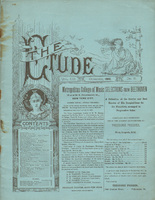BY T. CARL WHITMER.
To make “studies” of difficult measures in a composition is as of much value as “etudes” in general; perhaps of more direct value.
We need not have such a long list of “etudes” if we seek inside each thing we study for a difficult passage and, enlarging it, make it useful as a means as well as an end. We may say there are two ways of helping one to conquer a passage:
1st. By enlargement.
2d. By change of position.
The second seems almost contained in the first; yet it is distinct. We can see clearly now, by taking scales and arpeggios, and showing how not only they are at the bottom of passage work, but how their formation leads us to the thought that single passages can be developed in like manner and serve a purpose.
Let us take first Extension or Enlargement.
A one octave scale is but an enlargement of two or three or four notes.
A two octave scale is but an enlargement of a one octave scale. And so on. An arpeggio having within itself the intervals within the octave, is an enlargement of two or three notes, which themselves are alterations of a scale.
Two octaves of the same are but an extension of one octave.
Now, of course, one octave is harder to play than three notes; two octaves harder than one octave. And so on.
Before applying this, let us take the change of position. A passage is easy at centre of piano, difficult at both extremes, and of medium difficulty between the extremes and center. Then, applying both, we say—in singling out a measure of difficulty—the easiest and best direct way of conquering it is to take that one measure and continue it, that is, play it in one octave, then in two octaves, and, indeed, from one end of the piano to the other.
This brings with it, of course, change of position, but, as was said, this is really distinct, and I would say, play a high passage higher; play a high passage low; play a low passage lower; play a low passage high; also the passages which lie between may be played in other positions.
We may also say that what is played in the right hand can be better controlled if learned also with the left hand, and vice versa. But this brings with it such a train of difficulties not necessary that it can hardly be supported so strongly as the singling out of a passage and enlarging it or changing its position in order to “bound” or surround one’s grasp of the execution of the measure selected.
It is well known that one can play a passage better as it stands if that passage has been conquered on all sides. So this thought gained from a study of the scales is offered.
An excellent way to get pupils to understand and appreciate a passage occurring in the “inner parts” of a composition, is to select that passage, use it as a melody, and harmonize it several ways. The pupil will see it at its true value when he recognizes that it is worthy of standing as a melody.
So many of Beethoven’s Sonatas have interesting inner parts to “bring out,” that this method was resorted to in order to let them appreciate it.



